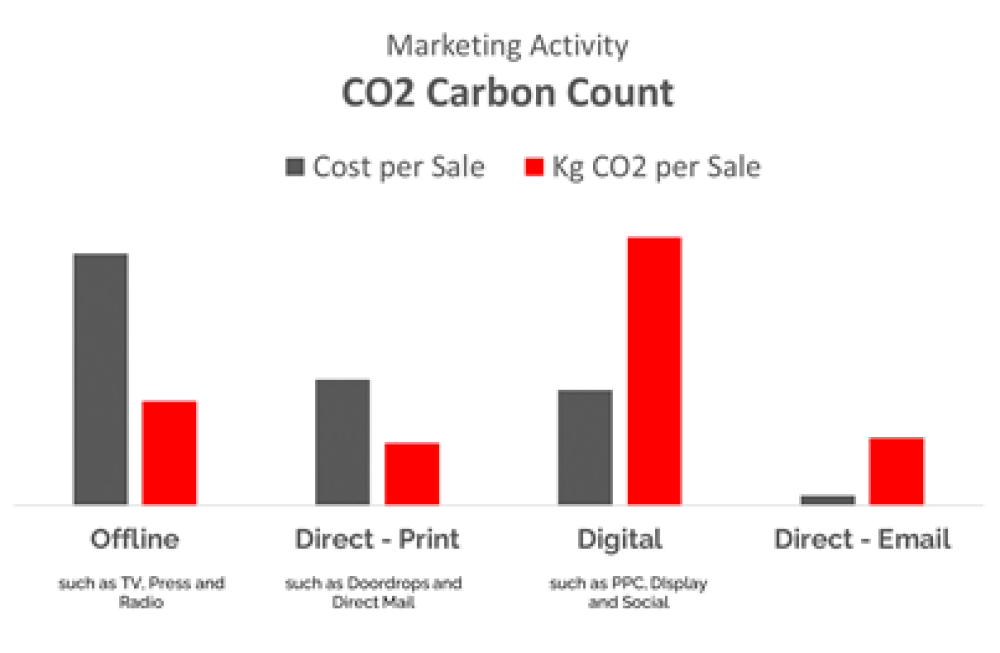Why email and digital activity is not always the greener option
29 Mar 2022

When it comes to measuring the carbon footprint of quantifiable marketing activities, such as advertising in newspapers or catalogue production, it’s relatively easy. Most marketers have experience of the production process, from tree to paper and from print to post, and instinctively try not to waste paper and recycle where possible.
At UniFida we talk to many marketers about this subject and find that most are uncertain about the relative carbon footprint of digital media channels. And for those with no way of measuring it, there is a common misconception that digital marketing is greener and more efficient than non-digital (offline) channels.
Sending one direct mail letter does arguably have a larger carbon footprint than sending one email. However, since email is seen as a cheap and effective channel, the volumes of emails being sent are rising significantly – whereas companies tend to be more cautious about ramping up costly direct mail.
Budgets shifting
Nevertheless, with marketing budgets shifting from offline media (such as TV and radio) to email and digital marketing, there will come a point when the carbon footprint of increasing volumes of online activity exceeds the footprint of offline spend.
Making digital and email activity the biggest part of the marketing footprint is likely to create some surprises. This is illustrated in the case study below.
In this example, offline spend such as TV, Press and Radio, although still significant, has dropped to 45% of the marketing budget. Digital spend (across mainly Display, PPC and Social) is 52% of the budget and the remaining 3% is split 2.5% to direct mail and door drops and 0.5% to email. In terms of efficiency, typically offline media has a higher Cost per Sale, followed by printed direct marketing and digital activity, with the lowest cost per sale being email.
However, driven by the sheer volume of email activity, the carbon footprint per sale for email (Kg CO2 per Sale) is more than the printed direct marketing activity. More surprisingly, for digital activity (driven by the volume of impressions, PPC bidding and social posts), the carbon footprint per sale is much higher than all other channels.
Where do emissions come from?
Some of the digital footprint comes from CO2 emitted on customer devices and their Wi-Fi networks, but most of the footprint is from the data centres and vast servers creating, storing and distributing the content.
Let’s think about this. A single printed direct mail piece does have a higher carbon footprint than an email. But as there are so many emails being sent out, when we look at the sales coming in through email, the CO2 per sale through email is greater than the CO2 through direct mail. Although the cost per sale is good, the high CO2 per sale is an indicator that many emails are being sent that are not generating sales.
So, for a channel where it is possible to target by individual and even predict response, shouldn’t we be aiming for less wastage from email?
In our example, for each sale through digital activity, we see the carbon footprint is very high and exceeds even offline activity – warning again that there is likely to be wasted effort, both in the marketing budget and in carbon. Focused analysis of the customer journey attribution paths will be able to confirm where the wasted effort is, so that something can be done about reducing the carbon footprint and, in turn, improving cost per sale further.
As budget custodians we are right to focus on a lower cost of sale but, as our case study indicates, it may be that our carbon footprint can help to point out further wastage across channels.
So, apart from the obvious reason of saving the planet, carbon counting our marketing activity is a win for the budget too. If we are more targeted and more probing of our marketing results, we can eliminate more wastage in the budget – and reduce the carbon footprint.
UniFida CO2 Counter
In January this year UniFida launched a CO2 Counter so that companies can measure and understand the sustainability of their marketing activities. It provides an understanding of the carbon footprint of each activity and helps businesses reduce carbon emissions from their marketing. Find out more.

Please login to comment.
Comments